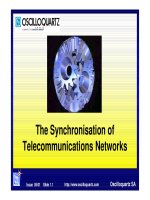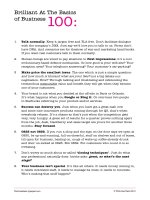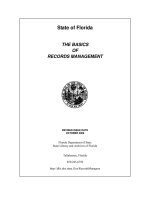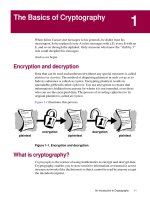The Basics of Telecommunications pps
Bạn đang xem bản rút gọn của tài liệu. Xem và tải ngay bản đầy đủ của tài liệu tại đây (14.12 MB, 288 trang )
Telecommunications Handbook
for Transportation Professionals
The Basics of Telecommunications
Final Report
September, 2004
Notice
This document is disseminated under the sponsorship
of the Department of Transportation in the interest of
information exchange.
The United States Government assumes no liability for its contents or use thereof.
Technical Report Documentation Page
1. Report No.
FHWA-HOP-04-034
2. Government Accession No.
3. Recipient's Catalog No.
5. Report Date
August, 2004
4. Title and Subtitle
Telecommunications Handbook for Transportation Professionals
The Basics of Telecommunications
6. Performing Organization Code
7. Author(s)
Sheldon Leader
8. Performing Organization Report No.
10. Work Unit No. (TRAIS)
9. Performing Organization Name and Address
11. Contract or Grant No.
13. Type of Report and Period Covered
12. Sponsoring Agency Name and Address
14. Sponsoring Agency Code
15. Supplementary Notes
16. Abstract
This handbook was created to provide individuals responsible for managing and implementing Traffic
Signal, and Freeway Management programs with an understand of the basic technologies of
telecommunications. The handbook provides a brief look at the history of telecommunications so that
its readers may gain an understanding of why various processes exist, and how the technologies
evolved. The handbook is not designed to be used as a specification for telecommunication systems.
The technologies associated with telecommunications are in a constant state of change. This handbook
was written over a two year period between August, 2002 and June 2004. During this time, a number of
emerging technologies began to reach maturity. The most significant of these, wireless internet access,
and voice over IP have caused the major carriers (telephone companies) to announce the construction of
new facilities to provide “Internet Telephony” services.
Readers of this handbook should gain an understanding of the basic technologies underlying most
telecommunications systems designed to transmit both voice and data information.
17. Key Word
Telecommunications
18. Distribution Statement
19. Security Classif. (of this report)
20. Security Classif. (of this page)
21. No. of Pages
287
22. Price
This Page Intentionally Blank
5
FOREWORD
This handbook was created to provide individuals responsible for
managing and implementing Traffic Signal, and Freeway
Management programs with an understanding of the basic
technologies of telecommunications. The handbook provides a
brief look at the history of telecommunications so that its
readers may gain an understanding of why various processes
exist, and how the technologies evolved. The handbook is not
designed to be used as a specification for telecommunication
systems.
The technologies associated with telecommunications are in a
constant state of change. This handbook was written over a two
year period between August, 2002 and June 2004. During this
time, a number of emerging technologies began to reach maturity.
The most significant of these, wireless internet access, and voice
over IP have caused the major carriers (telephone companies) to
announce the construction of new facilities to provide “Internet
Telephony” services. This construction is to start in 2004.
Welcome to the future!
6
ACKNOWLEDGEMENTS
The author would like to acknowledge the invaluable contributions
of the following individuals for volunteering their time to review
this document:
• Karen Jehanian, KMJ Consulting, Haverford, PA
• Jambala (Jay) Ruit, Edwards and Kelcey, Inc., West Chester,
PA
• Jeffery Purdy, Edwards and Kelcey, Inc., West Chester, PA
• Richard Easley, E2 Engineering, Ashburn, VA
• Ray Cauduro, GDI Systems, LLC, Newport, OR
The following individuals supported the overall development of
this document:
• Paul Olson, FHWA, San Francisco, CA
• Bill Jones, FHWA, Washington, D.C.
• Lou Neudorf, Siemens ITS, New York, NY
• Robert Reiss, Dunn Engineering Associates, Westhampton
Beach, NY
• Robert Gordon, Dunn Engineering Associates, Westhampton
Beach, NY
• Warren Tighe, Siemens ITS, Concord, CA
7
TABLE OF CONTENTS
1. Chapter One - Telecommunication Basics 15
Introduction 15
Purpose 15
Relationship to National Architecture 16
Open System Interconnection Model (OSI) 16
Telecommunications History 18
Handbook Organization 20
2. Chapter Two – Fundamentals of telecommunications 23
Introduction 23
Transmission Media 25
Media Consideration Factors 26
Wireline Media 28
Transmission Signaling Interfaces 52
Data & Voice Signaling - Basics 53
Electro-Mechanical Signal Interfaces 54
Video Transmission 55
Video Compression 57
Video CODECS 57
Video Compression 58
Streaming Video 60
Basic Telephone Service 61
Multiplexing 63
Time Division Multiplexing 64
Packet Division Multiplexing 65
T-1 Communication Systems 66
Transporting Digital Communications via an Analog Network 68
High Capacity Broadband Transmission 69
T-1/DS-1 & T-3/DS-3 70
DSL 71
SONET 72
ATM 73
FDM 75
WDM – CWDM & DWDM 75
Ethernet 76
Conclusions 81
3. Chapter Three – Telecommunications & The National ITS Architecture 83
Introduction 83
Overview – The National ITS Architecture 84
Vehicle-to-Vehicle (VtV) 85
National ITS Architecture Flows & Telecommunications 89
Market Packages 90
Example Illustration 92
Application of Telecommunications Using the National Architecture Flows 94
8
Comparison of Rural and Urban Telecommunications Requirements Using the National
Architecture Flows 97
Rural Systems 98
National Transportation Communication for Intelligent Transportation Systems Protocol (NTCIP)
100
Conclusion 105
4. Chapter Four – Developing the Telecommunication System 106
Introduction 106
Selecting the Consultant 106
There’s no substitute for experience 107
Different Telecommunication Design Specialties 108
Types of Telecommunications Experience 108
Knowledge of Telecommunications Systems Relationships 109
Educational Qualifications 110
Requirements Analysis 113
The “Gee-Whiz” Factor 115
Keep expectations realistic – ask questions 115
A Systematic Engineering Approach to the Requirements Analysis 116
Key points to consider: 117
Ask The Questions 117
Creating The Requirements Document 121
Three Basic Systems Types: 122
Developing a Budget 122
Conclusion 123
A few simple guidelines to follow: 123
5. Chapter Five – Telecommunications for Field Devices 124
Basic Communication Circuits for Field Devices 126
Basic Circuit Types 126
The Design Process 128
Traffic Control Device Circuits 134
Traffic Control System 135
Basic Data Circuit Types 136
Basic Traffic Device Type Communication Circuits 138
Basic Video Communication Circuits 141
Video-over-IP (VIP) 147
Basic Traffic and Freeway Management Networks 151
Basic Device Networks 151
Complex Communication Networks 152
Summary 160
Network Topology 162
Point-To-Point Networks 163
Star Networks 163
Ring Networks 164
Mesh Networks 165
Network Redundancy 167
Conclusion 167
6. Chapter Six – Maintenance & Warranties 168
9
Introduction 168
Why create a Maintenance Budget? 169
Creating the Maintenance Budget 172
Warranties, Extended Warranties & Service Plans 177
Warranties 178
Extended Warranties 179
Relationship of Warranties to System Specifications 181
Service Plans 181
Conclusions 184
7. Chapter Seven – System Examples 185
Introduction 185
Utah DOT System 186
Background 186
The System - Existing 188
The System - New 191
City of Irving Texas 193
Background 193
Proposed Update 194
5.8 GHz Attributes 196
Theory of Operation 197
The Irving Proposal 198
Tie-in To Main Communication Network 202
Conclusion 203
8. Chapter Eight – Construction 204
Introduction 204
Handling and Installation of Fiber Optic (and Copper) Communications Cable 205
Receiving and inspecting fiber optic cable 206
Unloading, moving and storing cable 207
Testing the cables 208
Documentation and record maintenance 210
General Cable, Installation and Design Guidelines 211
Cable Pull-box/Splice-box Placement 211
Cable Installation and Pulling Guidelines 212
General Cable Construction Guidelines 214
Aerial Construction 215
Direct Burial Construction 218
Conduit Construction 219
Wireless Systems Construction 220
Planning for Wireless Systems 221
A Word About Antennas 224
Guidelines for Handling & Installation of Wireless Antenna and Transmission Cable 224
Conclusion 226
Resources: 226
9. Chapter Nine – The internet 227
Introduction 227
What is the Internet? 227
History of the Internet 228
10
The Internet and the World-Wide-Web 229
How Does the Internet Work? 233
Addressing – Formats 235
Types of Internet Networks 237
Role of the Internet for Traffic, ITS, Freeway Management & Traveler Information 239
Use of the Internet for Center-to-Center Communications 241
Conclusions 246
10. Chapter Ten – The Future 247
Introduction 247
Circuit Switched Vs. Packet Switched 247
Trends for Transportation 249
High Speed Ethernet 249
Resilient Packet Ring (RPR) 251
Broadband Wireless 252
Radio Frequency Identification (RFID) 253
Conclusions 254
11. Appendix 256
IEEE 802 Standards & Working Groups 256
Comparison Analog Voice & VoIP 257
Calculating Fiber Optic Loss Budget 258
Criteria & Calculation Factors 258
Calculating a “Loss Budget” 259
Rural Telecommunications Requirements Testimony 262
Steve Albert – Senate hearing 262
About the Author 268
Glossary 269
11
LIST OF TABLES
Table 1-1: OSI Protocol Stack 17
Table 2-1: Twisted-Pair Communication Cable Category Ratings 31
Table 2-2: Fiber Optic Cable Classifications 35
Table 2-3: Fiber Cable Color Identification Chart 36
Table 2-4: Fiber Optic Cable Buffer Types 39
Table 2-5: Comparison Single Mode Fiber & Multimode Fiber 43
Table 2-6: Frequencies for Unlicensed Radio Systems 49
Table 2-7: CEA Estimates of the Number of Low Power Radio Devices 50
Table 2-8: Comparison of TDM & PDM 66
Table 3-1: DSRC Vehicle-Roadside Relationships 87
Table 3-2: Communication Needs & Requirements 94
Table 3-3: NTCIP Device Management Protocol List 104
Table 3-4: NTCIP List of Systems Management Protocols 104
Table 5-1: Location of Field Controllers 129
Table 5-2: Location & Data Requirements Table 131
Table 5-3: DB-25 Connector Cable 133
Table 5-4: Voice, Video & Text Transmission Requirements 143
Table 5-5: Field Device Location 158
Table 6-1: Example Communication Device Inventory List 171
Table 6-2: Technician Experience Classification 173
Table 7-1: Deployment Cost Estimates 191
Table 8-1: Example of Manufacturer Recommended Span Lengths for Areial Cable Segments 216
Table 9-1: Internet Communication Elements 242
Table 10-1: Comparison Traditional CCTV vs. VIP Systems Requirements 250
Table 11-1: IEEE 802 Standards List 256
Table 11-2: Fiber Loss Budget Calculation 259
12
LIST OF FIGURES
Figure 1-1: Diagram - NTCIP Standards Framework 17
Figure 1-2: Telecommunication Timeline 20
Figure 2-1: RJ45 Connector 29
Figure 2-2: Twisted Pair Cable 30
Figure 2-3: Co-Axial Cable Illustration 32
Figure 2-4: Basic Fiber Optic Strand Construction 33
Figure 2-5: Fiber Optic Cable Illustration 36
Figure 2-6: Diagram of Basic Connector Wiring 54
Figure 2-7: Illustration of Basic Telephone Call Process 62
Figure 2-8: TDM Process Flow Chart 64
Figure 2-9: Flow Chart - PDM Process 65
Figure 2-10: Diagram of Computer Digital Output Converted to Analog using a MODEM 67
Figure 2-11: Diagram of Analog Inputs to T-1 Mux 69
Figure 2-13: DWDM Channels 75
Figure 2-14: Diagram - Typical Office LAN 80
Figure 2-15: Diagram - Metro Area Network (MAN) 81
Figure 3-1: National ITS Architecture Communications Sausage Diagram 83
Figure 3-2: Diagram - Mobile 2-Way Radio Network 86
Figure 3-3: National Architecture EM-4 Market Package 90
Figure 3-4: EM-4 Market Package with Telecommunications Flows 92
Figure 3-5: EM-4 Market Package with "Sausage Diagram" Elements 93
Figure 3-6: TMC Area of Responsibility 94
Figure 3-7: Diagram - TMC to EMA Link 95
Figure 3-8: Diagram - TMC to EMA with Fiber Communication Link 96
Figure 3-9: Diagram - TMC to EMA Comm Link Rural Setting 97
Figure 3-10: Diagram - TMC to EMA Rural using Leased Telephone Lines 98
Figure 3-11: NTCIP Standards Framework 100
Figure 4-1: Field Devices Communication Link Requirements 113
Figure 4-2: Chart Relationship Communication to Overall System 114
Figure 5-1: Diagram - Technology Flow 124
Figure 5-2: Diagram - 3 Types of Communication Circuits 127
Figure 5-3: Napkin Sketch of Communication System 129
Figure 5-4: Location Map 130
Figure 5-5: System Schematic 132
Figure 5-6: DB-25 Connector 134
Figure 5-7: DB-9 Connector 134
Figure 5-8: Modem Block Diagram 136
Figure 5-9: CCTV Circuit Diagram 137
Figure 5-11: Diagram Field Controller to Host Computer 138
Figure 5-12: Diagram - Point-to-Multipoint 139
Figure 5-13: Diagram - Multidrop System 140
Figure 5-14: Diagram - FDM Hub Circuit 144
Figure 5-15: Diagram - CCTV with CODEC 145
Figure 5-16: Diagram - Typical CODEC Communication Circuit - 1990's Deployment 147
Figure 5-17: VIP Basic Camera System 149
Figure 5-18: Diagram - Add-on Conversion to VIP 150
Figure 5-19: Diagram - Basic Traffic Device Communication Circuit 151
Figure 5-20: Diagram of described system 153
Figure 5-21: Diagram STSS Communication System 154
Figure 5-22: Diagram UTSS Communication System 156
13
Figure 5-23: Straight Line Diagram 156
Figure 5-24: Diagram - Site Equipment 159
Figure 5-25: System Block Diagram 160
Figure 5-26: Diagram - Point-to-Point Network 163
Figure 5-27: Diagram - Star Network 164
Figure 5-28: Diagram - Ring Network 164
Figure 5-29: Diagram - Mesh Network 166
Figure 6-1: Photograph of a Fiber Optic Modem 170
Figure 7-1: Diagram UDOT Current System 190
Figure 7-2: Graph - Comparison of Savings Realized by UDOT Converting to an IP Architecture 191
Figure 7-3: Diagram - Comparison Multi-Drop VS. Ethernet 192
Figure 7-4: Diagram - Wireless Channel Alignment for 360 Degree Coverage 195
Figure 7-5: Diagram - Channel Re-use Plan for Wide Area Coverage 197
Figure 7-6: Diagram - Proposed Channel Re-use Plan 198
Figure 7-7: Drawing - Typical CCTV Site 199
Figure 7-8: Typical CCTV Site Schematic 200
Figure 7-9: Map of Proposed Irving Texas System 201
Figure 7-10: Schematic - Microwave Backbone Configuration 202
Figure 7-11: Diagram - Microwave Backbone 203
Figure 8-1: Fiber Cable Route Construction – Photograph Courtesy Adesta, LLC 204
Figure 8-2: Fiber Cable Route Construction – Photograph Courtesy Adesta, LLC 204
Figure 8-3: Fusion Splicing Fiber Strands - Photograph Courtesy Adesta, LLC 209
Figure 8-4: Aerial Fiber Optic Cable Splice Box - Photograph Courtesy Adesta, LLC 212
Figure 8-5: Typical Telephone Pole 217
Figure 8-6: Installation of Wireless System - Photograph Courtesy GDI Systems, LLC 220
Figure 8-7: Example of Antenna Coverage Pattern - Antenna Specialists Products 224
Figure 9-1: Actual Sketch of the Original Internet Concept 228
Figure 9-2: Map - Location of Major MCI Internet Nodes in United States 229
Figure 9-3: Diagram General Internet Architecture 232
Figure 9-4: Diagram - Traveler Information Provided via the Internet 234
Figure 9-5: National ITS Architecture Sausage Diagram with Internet added 240
Figure 9-6: Internet Elements Schematic 243
Figure 9-7: Schematic - Multiple Agency Center-to-Center Links via the Internet 244
Figure 9-8:ITS Center-to-Center Communication Diagram 245
14
This Page Intentionally Blank
Chapter 1
15
1. CHAPTER ONE - TELECOMMUNICATION
BASICS
Introduction
The “Telecommunications Handbook for Transportation
Professionals” was originally published in 1987 as the
“Communications Handbook for Traffic Control Systems”. The
first (and only) update was initiated in 1991, and published in
1993. Given the significant advances in the technology of
telecommunications, and the complexities of Traffic and ITS
systems deployment its is necessary to create a new (rather than
a revision) handbook providing a broader view of
telecommunications technology as applied for traffic and
transportation purposes. This handbook provides a broad overview
of telecommunications technology and history.
Purpose
The “Telecommunications Handbook for Transportation
Professionals” is intended to provide an introduction to
telecommunication technology and process for transportation
engineers and project managers involved in the design and
deployment of traffic signal and freeway management systems.
The handbook can be used as a resource that provides an overview
of the various technical issues associated with the planning,
design, operation, and management of a communications system. It
is intended to provide the user with a better understanding of
applied communications technology and the considerations for use
in freeway and surface street networks.
The intended audience is transportation professionals who may be
involved with, or responsible for any phase in the life cycle of a
traffic signal or freeway management control network. This
includes all public or private “practitioners” (e.g., managers,
supervisors, engineers, planners, or technicians) involved with any
issue or decision (e.g., policy, program, funding, or system
implementation) and who may directly or indirectly influence the
performance of traffic on local arteries or freeway facilities.
These activities may include, but not be limited to, planning and
design, operational strategies, programs, and services that
support continuous management of travel and control of traffic,
and the technology infrastructure to provide these capabilities.
Telecommunications Handbook for Transportation Professionals
Chapter 1
16
Relationship to National Architecture
Telecommunications systems as part of the National ITS
Architecture are the connecting pathways that bind the various
elements of traffic signal, freeway management, and
transportation systems together. The National ITS Architecture
“sausage diagram” indicates how these elements are bound
together, but does not specify the telecommunication system. The
developers of the National ITS Architecture understood that
each telecommunication system would be uniquely designed to
meet the needs of each project.
The significant diversity of communications technologies and the
overall complexity of traffic signal, freeway management, and
transportation systems have created a need for traffic and
transportation professionals to implement the Systems
Engineering Process (SEP). This handbook provides a summary
(Chapter 4) of how to apply an SEP to the development of a
telecommunications system, for traffic signal and freeway
management systems development.
Open System Interconnection Model (OSI)
The OSI model is an International Standards Organization (ISO)
standard that defines a framework for implementing
telecommunication and software protocols. The OSI model is
organized into seven hierarchal layers. Control is passed from one
layer to the next starting at the application layer and proceeding
down to each successive layer and back as required for any given
process. Most of the functionality of the OSI model exists in all
communications systems - however, two or three layers may be
combined into one. The most significant role of the OSI model is
to serve as a reference for the development of other protocol
stacks. A detailed explanation of the OSI Model is provided in
the Addendum section of this handbook. Table 1-1, provides a list
of the OSI Model Protocol Stack.
Telecommunications Handbook for Transportation Professionals
Chapter 1
17
Table 1-1: OSI Protocol Stack
OSI Protocol Stack
Layer # Protocol
7 Application
6 Presentation
5 Session
4 Transport
3 Network
2 Data Link
1 Physical
Telecommunications hardware generally utilizes layers one and
two of the protocol stack. Modems, multiplexers, bridges,
routers, switches, media converters, codecs, etc. are examples of
the types of devices that exist at the physical and data link
layers of the protocol stack. All media and most of the protocol
converters are considered as layer one items. Some
communication hardware devices are designed to operate at
higher layers. A network router is often referred to as a “layer 3
router”. This is one of the few examples of communication
hardware that is designed to function above layer two. Most
communication systems are not designed using the OSI protocol
stack. This is because the hardware vendors have already taken
the OSI model into consideration for the design of their
products. The RS232 and RJ45 connectors built into the 2070
traffic controller are already layer one compliant. Serving as a
protocol stack model, OSI is used as the reference for the
development of most other communications protocols. The
National Transportation Control Interface Protocol (NTCIP)
1
has
a specially developed protocol stack based on the OSI model.
1
Telecommunications Handbook for Transportation Professionals
Chapter 1
18
Notice (figure 1-1) that the NTCIP protocol stack is modeled on
the OSI stack, and has embedded telecommunication standards.
Communication system designers would simply use the pre-defined
telecommunication standards. However, developers of software
control systems must be acutely aware of the NTCIP protocol
stack. NTCIP and its role in the development of a communication
system is explained in Chapter 3.
Telecommunications History
The history of modern-day communications technology can be said
to have started when Samuel Morse invented the wireline
telegraph in 1832. However, it was Alexander Graham Bell’s
invention of the telephone, in 1874, that led to the development
of our present day communications technology. Morse had simply
created a way for humans to extend their ability to transfer
information – instantly – over great distances. Bell gave us the
ability to have the most intimate form of communication over
distances – the use of our voices.
The concept of the telephone instrument – and the system that
allows it to work – was so strong that most communication
Figure 1-1: Diagram - NTCIP Standards Framework
Telecommunications Handbook for Transportation Professionals
Chapter 1
19
technology during the past 125 years was developed to support an
efficient voice communication network. It wasn’t until 2004 that
major telecommunication carriers announced the need to develop,
and support, a network designed for the purpose of transporting
digital data.
The wireless telegraph (now referred to as radio) was invented by
Guillermo Marconi in 1896
2
. When wireless communication was
finally able to be used for voice transmission, it emulated the
telephone system.
From 1874 to 1980, communication networks around the world
were constructed to facilitate the efficient and economical
transmission of voice conversations. Multiplexing and digital
transmission systems were developed to “cram” more voice
conversations into the existing copper wire communication
facilities.
The Internet, first developed in 1973 as a project for the U.S.
Department of Defense Advanced Research Projects Agency
(ARPA), initiated a profound change in the future development of
communications networks and technologies. Originally called the
Arpanet – linking several Universities and research laboratories –
it evolved into the world wide web (WWW). During this period,
there were a number of significant technology advances and
government enforced corporate reorganizations that helped to
change the direction of communications systems development:
1. Computing and communications technologies were provided a
big boost by the invention of the integrated circuit (IC) in
1959. The IC permitted development and manufacture of
smaller and more automated communication devices at a very
low cost.
2. The Carterphone Decision, by the U.S. Supreme Court, in
1968, made it possible for the connection of non-telephone
company owned devices (until this point, only devices owned
and operated by the telephone companies were permitted).
3. In the 1970s, fiber strands were first used as a
communication medium.
4. In 1983, the U.S. Supreme Court mandated reorganization
of AT&T was enforced.
2
Historically, Marconi is credited with the invention of the wireless telegraph, however, a landmark June 21, 1943 supreme court decision stated
that Marconi had violated Nikola Tesla's patents for wireless communications. See "United States Reports; Cases Adjudged in the Supreme
Court of the United States," Vol. 320; Marconi Wireless Telegraph Co. of America v. United States, pp. 1-80.
Telecommunications Handbook for Transportation Professionals
Chapter 1
20
New inventions coupled with increasing business and consumer
demand for computer and data communication services forced a
change in the nature of the development of communications
networks. By 1995, most installation of communications networks
was devoted to the efficient transmission of data generated by
computers. However, these networks were still based on a voice
communication design.
The development and introduction of broadband data
communications standards (IEEE 802 Series
3
) helped to create a
demand for communications networks designed to support data
communications.
By 2003, wireless (cellular telephone) networks were available to
almost every location of the United States (remote wilderness
areas still lack coverage). According to the Cellular
Telecommunications & Internet Association (CTIA), there were
more than 148 million wireless subscribers, and 92% were using
digital service.
A timeline of the support for traditional voice transmission
services versus data transmission services might appear as
follows:
By 2003, 63% of Americans use the internet, and 31% of home
users have broadband access
4
. In early 2004, Verizon, announced
a major upgrade of its basic telephone network to support
“Internet Telephony” or Voice over Internet Protocol (VoIP)
5
.
Southern Bell Corporation (SBC) also announced similar upgrades
for its networks.
Handbook Organization
The Telecommunications Handbook for Transportation
Professionals is organized to provide the reader with a logical
flow of information with a description of various communication
3
4
Pew Trust – “Internet & American Life”, December 2003. -
5
Ivan Seidenberg, CEO Verizon, at the Consumer Electronics Show, Jan 2004.
1876
Present1995
Telephone
Invented
Voice
Network
Dominance
Data
Network
Dominance
Starts
Figure 1-2: Telecommunication Timeline
Telecommunications Handbook for Transportation Professionals
Chapter 1
21
terms and technologies that are commonly used (or considered)
for the deployment of Freeway Management and Traffic Signal
systems. Technical descriptions are kept at a minimum
engineering level to provide non-communication professionals with
a basic understanding of the technologies.
Chapter Two – Telecommunications Fundamentals. Communication
technology is provided in a “basic to complex” order. The chapter
starts with copper based transmission media and steps the reader
through a progression of terminology that includes: fiber optics,
wireless, video multiplexing and Ethernet systems.
Chapter Three – Telecommunications & The National Architecture.
The chapter is a general look at the relationship of
telecommunications systems design and the National ITS
Architecture and NTCIP. The reader will be made aware of the
fact that NTCIP is not a standard, but a protocol that defines
the relationship of the many current (and developing)
communications standards for use in a traffic signal, freeway
management, or transportation system.
Chapter Four – Developing the Telecommunication System. This
chapter provides the reader with a system engineering approach
to the design of a communications system that supports traffic
and transportation requirements. The chapter provides a step-by-
step process that should result in a communication system
requirements analysis and preliminary design. The primary axiom
that drives the design of a communications system is - “there are
no absolutes!” For most communication systems there are usually
several ways to achieve the desired results. A qualified
communications system designer will generally present several
different approaches and ask the project manager to make a
decision.
Chapter Five - Communications for Field Devices. The chapter
provides an in-depth look at basic system configurations for field
devices used in traffic signal and freeway management systems.
Each field device has a specific set of communications
requirements.
Chapter Six – Communication System Maintenance. Maintenance of
a telecommunication system is essential. Operators of these
systems must provide for the care and feeding of the networks
that connect all field devices and operational centers. The
chapter discusses the need to create a budget for maintenance,
the relationship of manufacturer warrantees to maintenance, and
technician qualifications.
Telecommunications Handbook for Transportation Professionals
Chapter 1
22
Chapter Seven – System Examples. This chapter presents a look
at “real-world” systems deployed by departments of
transportation. Two systems are described to show how similar
problems use different approaches to a solution.
Chapter Eight – Installation and Testing. A major cost element in
the deployment of a communications system is installation
(construction). Very often, project managers assume that proper
installation procedures are being used by contractors. This
chapter provides guidelines for proper handling and installation
of communications media. Wireline and wireless media are
discussed.
Chapter Nine - The Internet. First conceived and implemented
nearly thirty years ago, has had a profound effect on the way
individuals, private companies and public organizations
communicate on a day-to-day basis. The chapter in this document
will provide the reader with a basic understanding of the
composition of the Internet, the World Wide Web (WWW), how it
works, and how it can be used as part of an overall
communications and operational strategy for Traffic Signal, FMS,
and ITS systems.
Chapter Ten - The Future. An attempt to provide some insight on
the general future of communications systems and the possible
implications for the deployment of telecommunications systems to
support Freeway Management and Traffic Signal systems.
Appendix A – Contains additional information that readers of this
handbook can use for investigation of additional resources. The
following items are included in this appendix:
• List of IEEE 802 standards and working groups
• Comparison of analog voice and voice-over-IP (VoIP)
• How to calculate a fiber optic loss budget
• A discussion of rural telecommunications requirements
Glossary – Definitions – will provide a listing of all terminology
used in this handbook.
Chapter 2
23
2. CHAPTER TWO – FUNDAMENTALS OF
TELECOMMUNICATIONS
Introduction
Transmitter, receiver, transmission medium - these are the basic
elements that make up a communication system. Every human
being is equipped with a basic communication system. The mouth
(and vocal cords) is the transmitter, ears are the receivers, and
air is the transmission medium over which sound travels between
mouth and ear. The transmitter and receiver elements of a data
modem (such as the type used in a traffic signal system
controller box) may not be readily visible. However, look at a
schematic of its components, and you will see elements labeled as
“XMTR” and “RCVR”. The modem’s transmission medium is typically
copper wire, fiber, or radio.
Almost all communications networks have as their basis the same
set of Telephony (Telepho–Ny) standards and practices. “Ma Bell”
(the Bell Telephone System and
American Telephone &
Telegraph, and others) spent
years and billions of dollars
creating, perfecting and
maintaining a
telecommunications network
dedicated to providing the
most reliable voice
communication service in the
world. All other communication
technology and process evolved based on that communications
network. Engineers and scientists involved in the development of
new communication technologies and processes had to make
certain that their “product” could be used within the existing
telephone networks. And, the telephone company required
backward compatibility. Telephones manufactured in 1950 still
work in today’s network. Modems manufactured in 1980 still work
in the current system.
As you read through this chapter, and the rest of the handbook,
please keep in mind that telecommunication standards, practices,
and protocols were developed for the communication industry. All
Some communication transmission
protocols were developed to work
independently of the Telephone System.
Ethernet, for example was created to
facilitate data communication within a
closed system that was contained within
an office building. The Internet was
created as a closed communication
network.
Telecommunications Handbook for Transportation Professionals
Chapter 2
24
of these systems must be adapted for use in a traffic signal or
freeway management system.
Today, in North America, Mexico, most of Europe and the Pacific
Rim, voice services are in fact sent as digital signals and
converted to analog just before leaving (and arriving at) the
serving central office, at the end-user points. The reader might
ask: “If voice is converted to digital isn’t that the same as
data?” The answer is no - “digital transmission” does not
automatically infer data communications compatibility. Analog
transmission systems can, and do, carry data. In
telecommunications, digital and analog are distinct forms of
communication transmission. This chapter provides information
about the basics of telecommunications - the transmission media
and transmission systems, as well as an explanation of the
differences between analog and digital transmission. Transmission
media are those elements that provide communication systems
with a path on which to travel. Transmission systems are those
elements (hardware and software) that provide management of
the communication process and
the use of the transmission path.
The telecommunications world
would be very simple if the
distinction between transmission
media and systems (protocols)
were easily defined. Often, a
specific transmission system will
only work within a specific
medium. Spread Spectrum Radio
is one example. Radio (RF) is the
transmission medium, and spread
spectrum is the transmission system (protocol). Although it is
possible to create a spread spectrum communications signal over
wireline, the process is not typically used because there are
other more efficient methods of transmission signaling.
Therefore, spread spectrum transmission signaling is almost
always associated with RF. There is always a point at which the
Spread Spectrum Radio system must interface with another
transmission medium, and/or system. This is accomplished by
converting from RF to a wireline signaling protocol. The
telecommunications process can be viewed as an excellent example
of multi-modalism.
For purposes of this discussion,
voice is any transmission that
can be switched through the
Carrier networks in an analog
format. This includes data
transmitted within a voice
channel using a modem. Data is
any digital transmission that
cannot be switched through the
Carrier networks.
Telecommunications Handbook for Transportation Professionals
Chapter 2
25
The chapter is divided into sections that cover
• Transmission Media
• Transmission Signaling
• Basic Telephone Service
• Multiplexing
• High Capacity and Broadband Transmission
Sub-topics in the sections look at:
• Media Consideration Factors (why use one over another)
• Differences between voice and data signaling
• Video Transmission (CODECS & Compression)
• T-1 Communication
• SONET, WDM & Ethernet
• Wireless
Transmission Media
Transmission media are the highways and arteries that provide a
path for telecommunications devices. There is a general tendency
to say that one transmission medium is better than another. In
fact, each transmission medium
has its place in the design of
any communication system. Each
has characteristics which will
make it the ideal medium to use
based on a particular set of
circumstances. It is important
to recognize the advantages of each and develop a system
accordingly.
Transmission efficiency is generally viewed as the amount of
signal degradation created by the use of a particular transmission
medium. The transmission medium presents a “barrier” to the
communication signal. The “barrier” can be measured by many
different factors. However, one common question is asked about
all communication media. How far will the communication signal
energy travel before it becomes too weak (or distorted) to be
considered unsable? There is equipment available to extend the
distance for transmitting a signal, but that adds to the overall
cost and complexity of deployment.
Factors to consider when
choosing transmission media
include: cost, ease of installation
and maintenance, availability, and
most important, efficiency of
transmission.









